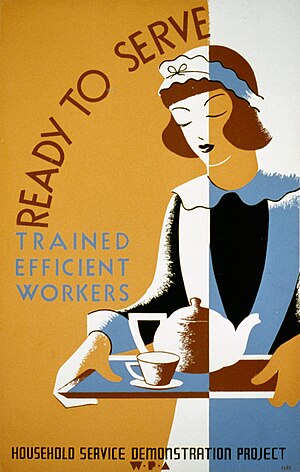
The Household Service Demonstration Project (HSDP) was a Works Progress Administration (WPA) project designed to train women for domestic employment. [1]

The Household Service Demonstration Project (HSDP) was a Works Progress Administration (WPA) project designed to train women for domestic employment. [1]
The project was an offshoot of the Household Workers’ Training Program. The WPA announced the project in March 1937. [2] It got under way around July 1937 [3] and ended it in January 1942. [4] The project was formally authorized by United States Congress in 1938. It offered training and employment in WPA training centers [5] giving demonstrations of housework. [6] The WPA designed it to promote the employment of women certified as qualified for private household employment and to promote the techniques of household service. [7]
The project trained 30,000 women. [8] Middle-aged women were preferred due to the perceived unreliability and increased risk of marriage of younger women. [9] The project employed 1,700 women to give two- and three-month courses in cooking and serving food, house and child care, washing, ironing, and marketing. [10] Other skills taught included table setting, [9] home management, budgeting and knitting. [9]
In Washington, during the course of their training, trainees were paid $46 a month. After passing written and oral exams, diplomas were awarded to graduates. [11] After completing training, a graduate could make $60 a month as a domestic. [9]
Demonstration sites were located at 400 South Capitol Street in Washington, DC, [12] and at 217 E Boone Ave in Spokane, Washington.
The HSDP was called Eleanor Roosevelt’s favorite project. [13] It was part of the WPA’s traditional emphasis. [14] The assistant state supervisor of seven household service projects in Pennsylvania was reported as saying, "There is something so obvious about a woman working in a home that I wonder why a project such as this wasn't begun many years ago."

The Works Progress Administration was an American New Deal agency that employed millions of jobseekers to carry out public works projects, including the construction of public buildings and roads. It was set up on May 6, 1935, by presidential order, as a key part of the Second New Deal.
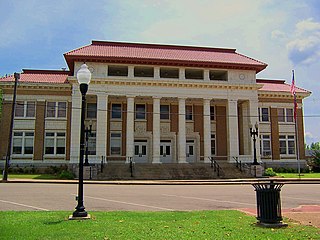
Pontotoc is a city in and the county seat of Pontotoc County, Mississippi, located to the west of the larger city of Tupelo. The population was 5,640 at the 2020 census. Pontotoc is a Chickasaw word that means, “Land of the Hanging Grapes.” A section of the city largely along Main Street and Liberty Street has been designated the Pontotoc Historic District and is listed on the National Register of Historic Places. The Treaty of Pontotoc Site is also listed on the National Register. The Treaty of Pontotoc Creek, part of U.S. president Andrew Jackson's Indian Removal policy, ceded millions of acres of Native American lands and relocated the Chicakasaw west of the Mississippi River.

Washington State University (WSU) is a public land-grant research university in Pullman, Washington. Founded in 1890, WSU is also one of the oldest land-grant universities in the American West. With an undergraduate enrollment of 24,278 and a total enrollment of 28,581, it is the second largest institution for higher education in Washington state behind the University of Washington. It is classified among "R1: Doctoral Universities – Very high research activity".

Wichita State University (WSU) is a public research university in Wichita, Kansas, United States. It is governed by the Kansas Board of Regents. The university offers more than 60 undergraduate degree programs in more than 200 areas of study in nine colleges. The university's graduate school offers more than 50 master's degrees in more than 100 areas and a specialist in education degree and 13 doctoral degrees. It is classified among "R2: Doctoral Universities – High research activity".

The Federal Theatre Project was a theatre program established during the Great Depression as part of the New Deal to fund live artistic performances and entertainment programs in the United States. It was one of five Federal Project Number One projects sponsored by the Works Progress Administration, created not as a cultural activity but as a relief measure to employ artists, writers, directors, and theater workers. National director Hallie Flanagan shaped the FTP into a federation of regional theaters that created relevant art, encouraged experimentation in new forms and techniques, and made it possible for millions of Americans to see live theatre for the first time. Although The Federal Theatre project consumed only 0.5% of the allocated budget from the WPA and was widely considered a commercial and critical success, the project became a source of heated political contention. Congress responded to the project's racial integration and accusations of Communist infiltration and cancelled its funding effective June 30, 1939. One month before the project's end, drama critic Brooks Atkinson summarized: "Although the Federal Theatre is far from perfect, it has kept an average of ten thousand people employed on work that has helped to lift the dead weight from the lives of millions of Americans. It has been the best friend the theatre as an institution has ever had in this country."
The Federal Art Project (1935–1943) was a New Deal program to fund the visual arts in the United States. Under national director Holger Cahill, it was one of five Federal Project Number One projects sponsored by the Works Progress Administration (WPA), and the largest of the New Deal art projects. It was created not as a cultural activity, but as a relief measure to employ artists and artisans to create murals, easel paintings, sculpture, graphic art, posters, photography, theatre scenic design, and arts and crafts. The WPA Federal Art Project established more than 100 community art centers throughout the country, researched and documented American design, commissioned a significant body of public art without restriction to content or subject matter, and sustained some 10,000 artists and craft workers during the Great Depression. According to American Heritage, “Something like 400,000 easel paintings, murals, prints, posters, and renderings were produced by WPA artists during the eight years of the project’s existence, virtually free of government pressure to control subject matter, interpretation, or style.”

A domestic worker is a person who works within a residence and performs a variety of household services for an individual, from providing cleaning and household maintenance, or cooking, laundry and ironing, or care for children and elderly dependents, and other household errands. The term "domestic service" applies to the equivalent occupational category. In traditional English contexts, such a person was said to be "in service".

Euthenics is the study of improvement of human functioning and well-being by improvement of living conditions. "Improvement" is conducted by altering external factors such as education and the controllable environments, including environmentalism, education regarding employment, home economics, sanitation, and housing, as well as the prevention and removal of contagious disease and parasites.
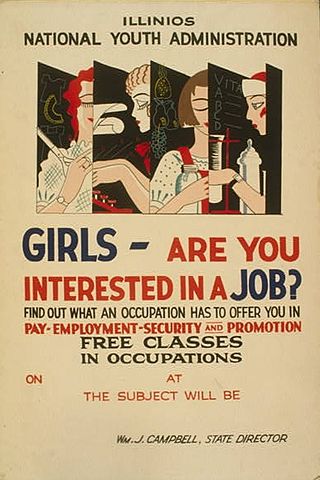
The National Youth Administration (NYA) was a New Deal agency sponsored by Franklin D. Roosevelt during his presidency. It focused on providing work and education for Americans between the ages of 16 and 25. It operated from June 26, 1935, to 1939 as part of the Works Progress Administration (WPA) and included a Division of Negro Affairs headed by Mary McLeod Bethune who worked at the agency from 1936 to 1943. Following the passage of the Reorganization Act of 1939, the NYA was transferred from the WPA to the Federal Security Agency. In 1942, the NYA was transferred to the War Manpower Commission (WMC). The NYA was discontinued in 1943.

Elson S. Floyd was an American educator who served as the 10th president of the four-campus Washington State University from May 21, 2007 to June 20, 2015. Floyd was also the first African American to be named president of Washington State University. Floyd also served as president of the University of Missouri System and president of Western Michigan University. Floyd was the Chairman of the Pac-12 CEO Group.
The Battle of the Palouse refers to an athletic rivalry in the northwest United States, between the Vandals of the University of Idaho and Cougars of Washington State University.
Domestic violence in Chile is a prevalent problem as of 2004. Domestic violence describes violence by an intimate partner or other family members, regardless of the place the violence occurs.
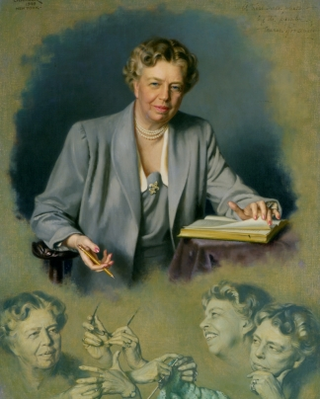
My Day was a newspaper column written by First Lady of the United States Eleanor Roosevelt (ER) six days a week from December 31, 1935, to September 26, 1962. In her column, Roosevelt discussed issues including civil rights, women's rights, and various current events. This column allowed ER to spread her ideas, thoughts, and perspectives on contemporary events to the American public through local newspapers. Through My Day, Roosevelt became the first First Lady to write a daily newspaper column. Roosevelt also wrote for Ladies Home Journal, McCall's, and published various articles in Vogue and other women's magazines.

We Work Again is a 1937 ephemeral film produced by the Work Projects Administration to promote its employment and training efforts for African-Americans during the Great Depression. Various jobs are shown, including public construction projects, domestic service and health care training, adult education programs and performing arts. It is particularly noted for containing the only existing footage of the 1936 Federal Theatre Project production of Macbeth, directed by Orson Welles and featuring an all-black cast.
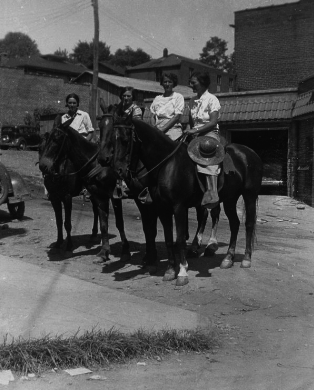
The Pack Horse Library Project was a Works Progress Administration (WPA) program that delivered books to remote regions in the Appalachian Mountains between 1935 and 1943. Women were very involved in the project which eventually had 30 different libraries serving 100,000 people. Pack horse librarians were known by many different names including "book women," "book ladies," and "packsaddle librarians." The project helped employ around 200 people and reached around 100,000 residents in rural Kentucky.
Washington State University Everett is a campus of Washington State University in Everett, Washington. The land-grant research university was founded in 1890 and the Washington State Legislature approved funding for WSU to expand to Snohomish County in 2011. The campus began with a 95,000-square foot building costing $64 million. The campus was founded in 2014, and courses began in late 2017.
This is a Timeline of second-wave feminism, from its beginning in the mid-twentieth century, to the start of Third-wave feminism in the early 1990s.
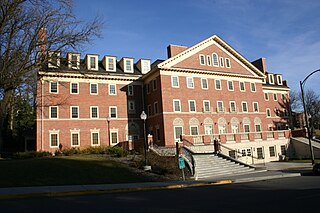
The Elmina White Honors Hall, also known as Honors Hall is a residence hall located on the main campus of Washington State University in Pullman, Washington. It was designed by Stanley Smith, the head of the architecture department at Washington State University (1924-1947), and was completed in 1928. It was later remodeled into student housing and faculty offices in 2001, costing $15.3 million. It is located in the northwest corner of Washington State University (WSU) in Pullman, Washington. Its original purpose was to house the Home Economics department as part of the College of Domestic Economy. Following the 2001 reconstruction, the four-story building, with a converted basement, was transformed into three floors of residential suites with classrooms, offices, and a library for the WSU Honors College on the ground floor, and several multi-purpose rooms in the basement. It was designed in a Georgian Revival style and was referred to as an “elegant architectural statement” in a report provided by the Washington State University Task Force for Historic Preservation in 1985.
Muriel Craigie, OBE (1889–1971) was a leading Scottish suffragist, honoured by two nations as a major volunteer organiser in both World Wars, and a 'noted educationist' during local authority education reforms.

Florence Kerr (1890–1974) was the director of the Women's and Professional Division in the Works Progress Administration (WPA) for the Midwest region.